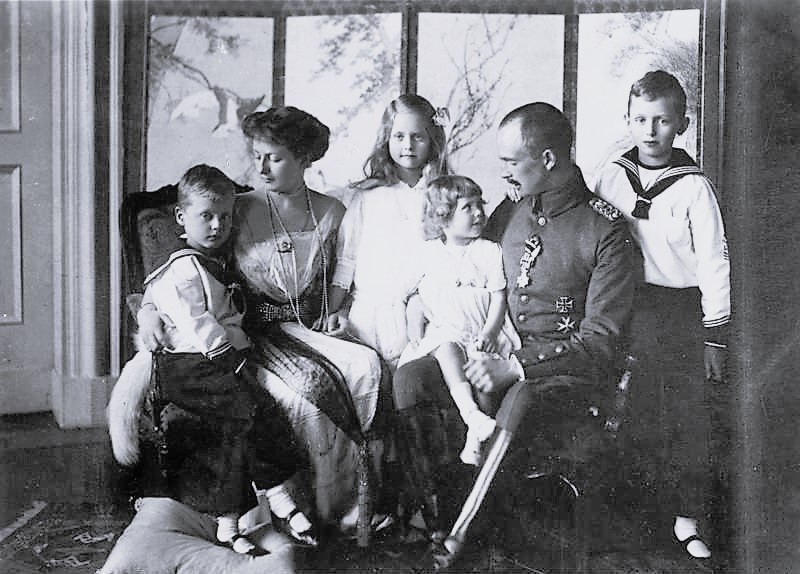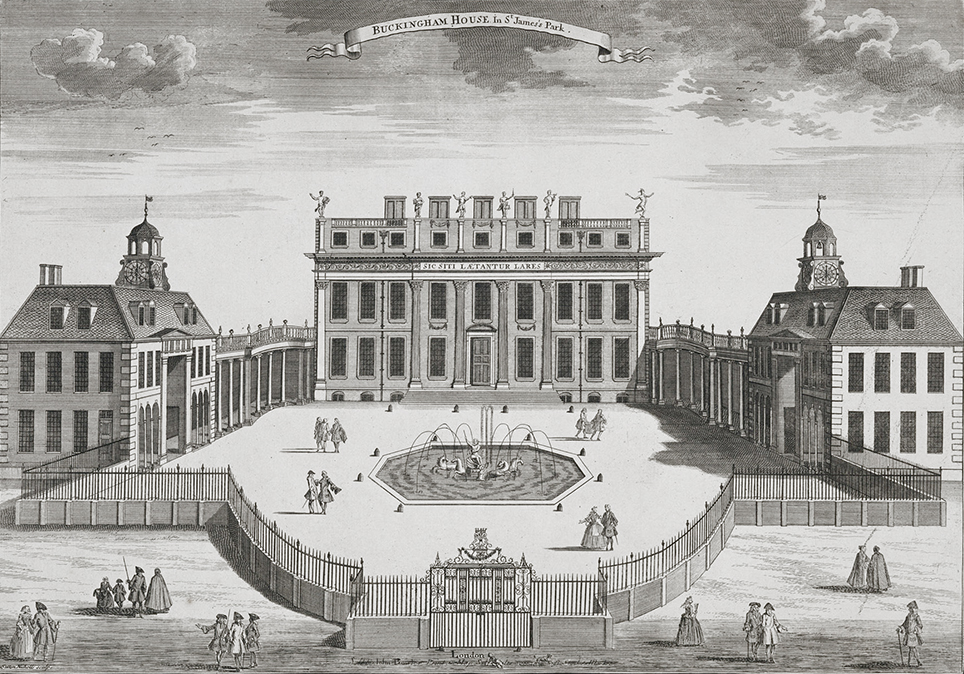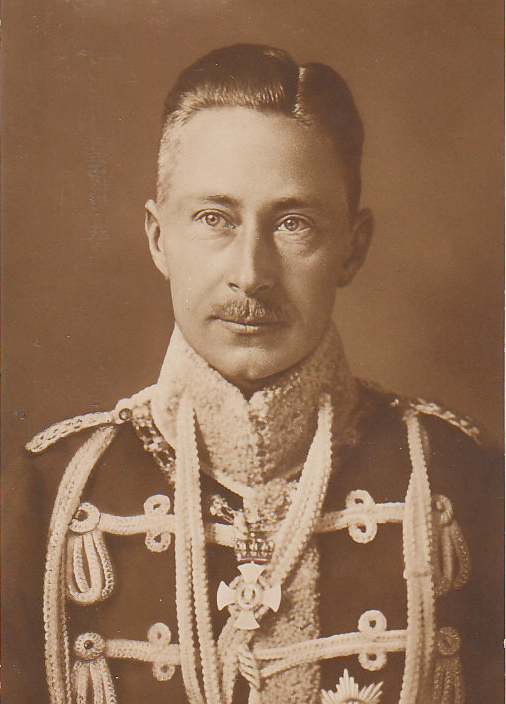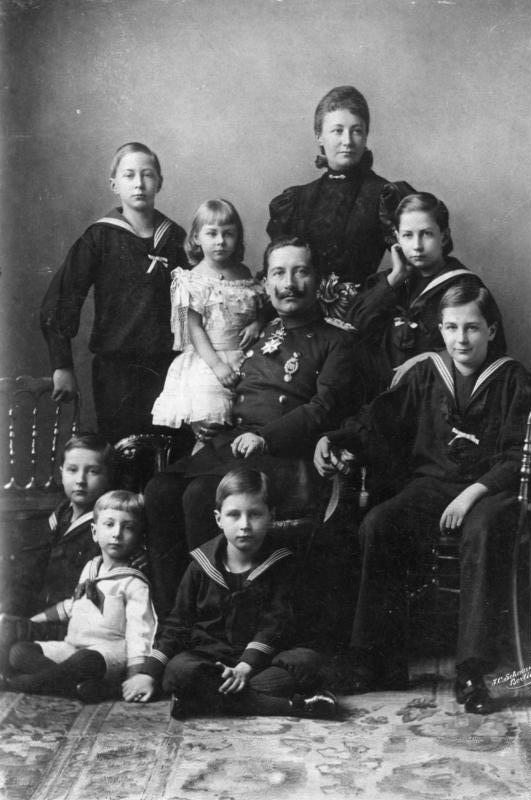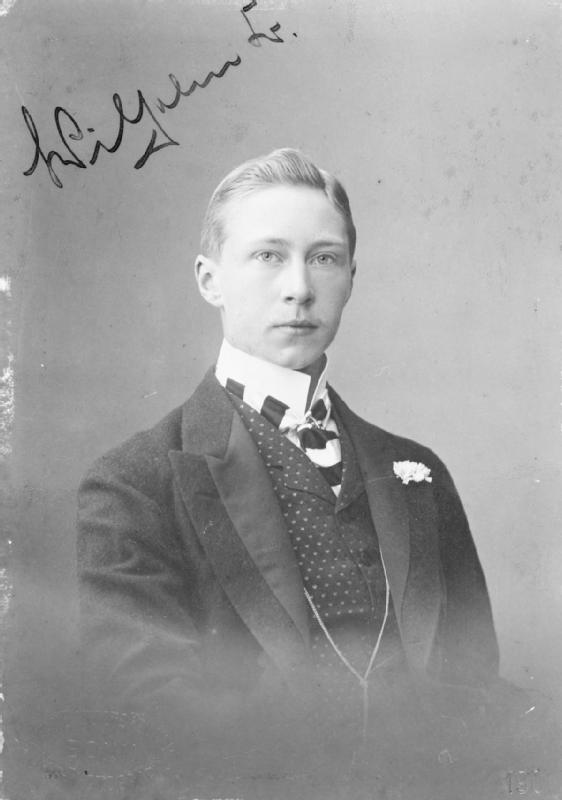by Scott Mehl © Unofficial Royalty 2015

Victoria Eugenie of Battenberg, Queen of Spain; Credit – Wikipedia
Princess Victoria Eugenie Julia Ena of Battenberg (known as Ena) was born on October 24, 1887, at Balmoral Castle in Scotland, the only daughter of Prince Henry of Battenberg and Princess Beatrice of the United Kingdom, the youngest daughter of Queen Victoria.
The infant princess was named after her grandmother Queen Victoria and for her godmother Eugénie de Montijo, the Spanish-born French empress and widow of Napoleon III, who lived in exile in the United Kingdom. To her family, and the British general public, she was known by the last of her names, as Ena. She was christened in the Drawing Room at Balmoral Castle on November 23, 1887.
Her godparents were:
- Eugénie, Empress of the French (born Eugénie de Montijo)
- Crown Princess Victoria of Prussia (her maternal aunt, born Victoria, Princess Royal)
- Julia, Princess of Battenberg (her paternal grandmother)
- Princess Christian of Schleswig-Holstein (her maternal aunt, born Princess Helena)
- Prince Louis of Battenberg (her paternal uncle)
- Prince Alfred, Duke of Edinburgh (her maternal uncle, the future Duke of Saxe-Coburg and Gotha)
Ena had three brothers:
- Prince Alexander of Battenberg, later Alexander Mountbatten, Marquess of Carisbrooke (1886-1960), married Lady Irene Denison, had one daughter
- Prince Leopold of Battenberg, later Lord Leopold Mountbatten (1889-1922), unmarried
- Prince Maurice of Battenberg (1891-1914), unmarried, killed in action in World War I
Raised in her grandmother’s household, the family moved constantly between Buckingham Palace, Windsor Castle, Balmoral Castle, and Osborne House. In January 1896, Ena’s father died of malaria while en route to fight in the Ashanti War. Following his death, Queen Victoria gave the family apartments at Kensington Palace, where they lived when in London. After Queen Victoria died in 1901, Kensington Palace became their primary residence, along with Osborne Cottage on the grounds of Osborne House.
In 1905, Ena met her future husband, King Alfonso XIII of Spain, while he was on a State Visit to the United Kingdom. The two soon began corresponding and quickly became smitten with each other. However, several issues needed to be resolved before they could consider marriage. First was the looming threat of hemophilia. Ena’s brother Leopold was suffering from the disease, so there was a very good chance that she might bring it to the Spanish royal family. However, with little known about the disease at the time, Alfonso did not seem too concerned. The bigger obstacles were Ena’s religion and, as far as Alfonso’s mother was concerned, her less-than-royal bloodline. However, Ena willingly agreed to convert to Catholicism, and her uncle, King Edward VII, elevated her rank to Royal Highness so there could be no question of an unequal marriage. This appeased Alfonso’s mother, and the engagement was announced.

Assassination attempt at Alfonso and Victoria Eugenie’s wedding, 1906.
The couple married on May 31, 1906, at the Royal Monastery of San Jerónimo in Madrid, in a wedding attended by many royals from around the world. The marriage was not, however, without incident. While the wedding procession was returning to the Royal Palace, an assassination attempt was made on the King and his new Queen. Both Alfonso and Ena were unharmed, however, several guards and bystanders were killed or injured.
Ena and Alfonso had seven children:
- Infante Alfonso, Prince of Asturias (1907-1938) – married (1) Edelmira Sampedro y Robato, no children, divorced (2) Marta Esther Rocafort-Altuzarra, no children
- Infante Jaime, Duke of Segovia (1908-1975) – married (1) Emmanuelle de Dampierre, had two sons, divorced (2) Charlotte Luise Auguste Tiedemann, no children
- Infanta Beatriz (1909-2002) – married Alessandro Torlonia, 5th Prince of Civitella-Cesi, four children
- Infante Fernando (1910-1910) – stillborn
- Infanta María Cristina (1911-1996) – married Count Enrico Marone, four children
- Infante Juan, Count of Barcelona (1913-1993) – married Princess Maria Mercedes of Bourbon-Two Sicilies, four children, the Spanish royal family descends from this marriage
- Infante Gonzalo (1914-1934) – not married

Queen Ena with her children in 1918 (from left to right) Maria Cristina, Alfonso, Gonzalo, Juan, Jaime and Beatriz; Credit – Wikipedia
After the birth of the first son Alfonso, it was discovered that he was suffering from hemophilia. Despite knowing the risks beforehand, King Alfonso blamed Ena, beginning a rift in their marriage that would never fully heal. In the end, only their first and last sons had the disease. See Unofficial Royalty: Hemophilia in Queen Victoria’s Descendants.
Victoria Eugenie worked with charities that supported the poor, promoted education, and took a particular interest in nursing and hospital care. She would later be instrumental in reorganizing the Spanish Red Cross and is often credited with helping to advance the healthcare system in Spain. Despite a somewhat rocky relationship at first, she soon became greatly admired and loved by the Spanish people.
Following the establishment of the Second Spanish Republic in 1931, the family went into exile. Settling first in France and then Italy, Ena and Alfonso soon went their separate ways. Ena returned to London, taking up residence at 34 Porchester Terrace to be close to her mother. In 1938, she reunited with her husband in Rome, for the christening of their grandson, Juan Carlos, future King of Spain. The following year, Ena left London and returned to Rome. Despite their separation, she was concerned about Alfonso’s diminishing health and wanted to be nearby. Alfonso died in February 1941, surrounded by his family. Less than a year later, she was forced to leave Italy, as members of Mussolini’s government accused her of spying. She settled in Lausanne, Switzerland, at the Hotel Royal. Several years later, in 1947, Ena purchased a villa – Vieille Fontaine – in Lausanne. It was here, in 1961, that she welcomed the media to announce the engagement of her grandson Juan Carlos and Princess Sophia of Greece.
Queen Victoria Eugenie’s later life was spent enjoying her grandchildren and her busy social schedule. Shortly after Grace Kelly married Prince Rainier III of Monaco, Ena took the young Grace under her wing, helping her adjust to her new royal life. A lifelong friendship ensued, and Ena was asked to be godmother to their son, the future Prince Albert II. She was also the godmother to Queen Fabiola of Belgium and the late Duchess of Alba.
In February 1968, Queen Victoria Eugenie returned to Spain for the first time since going into exile in 1931. Staying at the Palace of Liria with her goddaughter, the Duchess of Alba, Ena was there to serve as godmother to her new great-grandson, the future King Felipe VI of Spain. She was deeply touched by the crowds who came to greet her wherever she went and tried to see as many things as she could during her short visit. After the christening, she allegedly took General Franco aside to discuss the monarchy’s future, particularly the succession to the throne. Several different stories exist about the actual conversation, but Ena had previously stressed that it would probably be best to skip over her son Juan, and entrust the future of the monarchy and Spain to Juan Carlos.
Ena’s trip to Spain would be one of her last public appearances. She returned to her home in Switzerland, and soon her health began to fail. Victoria Eugenie of Battenberg, Queen of Spain, passed away on April 15, 1969, at her home in Lausanne, Switzerland, surrounded by her family. Ironically, it was 38 years to the day that she had been forced to leave Spain in 1931. Her funeral was held at the Church of the Sacred Heart in Lausanne, Switzerland, and she was buried in the nearby Cemetery Bois-de-Vaux. In April 1985, her grandson, King Juan Carlos, had her remains returned to Spain, where they were interred in the Pantheon of the Kings in the Royal Crypt of the Royal Basilica of San Lorenzo de El Escorial in San Lorenzo de El Escorial, Spain.
This article is the intellectual property of Unofficial Royalty and is NOT TO BE COPIED, EDITED, OR POSTED IN ANY FORM ON ANOTHER WEBSITE under any circumstances. It is permissible to use a link that directs to Unofficial Royalty.
Kingdom of Spain Resources at Unofficial Royalty
- Kingdom of Spain Index
- Line of Succession to the Throne of Spain
- Monarchs of a United Spain (since 1516)
- Profiles of the Spanish Royal Family
- Spanish Royal Burial Sites
- Spanish Royal Christenings
- Spanish Royal Dates
- Spanish Royal FAQs
- Spanish Royal Links
- Spanish Royal Weddings
- Spanish Royal Residences





